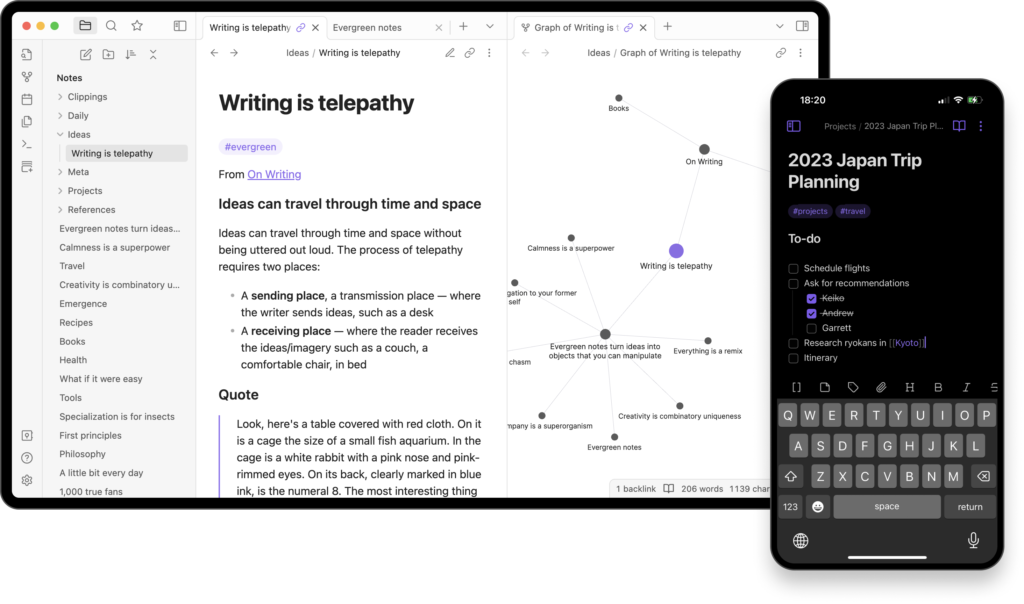In the ever-evolving digital world, where our lives are increasingly documented through photos, videos, and online interactions, managing this growing collection of digital artifacts can feel overwhelming. How can we transform this chaos into a meaningful, accessible legacy? Enter Knowledge Management Systems (KMS) like Obsidian, a powerful tool for creating your very own digital museum—a structured, interactive space for preserving and celebrating your personal story.
Why Create a Digital Museum?
Our digital lives are like vast treasure troves of memories. Each photo, video, email, and social media post represents a moment in time, a piece of our unique story. Building a digital museum provides:
- Preservation of Legacy: Safeguard cherished memories against loss or forgetfulness.
- Reflection and Growth: Gain deeper insights into your life’s journey by revisiting pivotal moments.
- Connection Across Generations: Share your story with loved ones, providing future generations a rich connection to their heritage.
Getting Started with Your Digital Museum
To begin, choose a robust tool like Obsidian. Its flexibility and powerful features make it an ideal choice for crafting a personalized digital vault.
Step 1: Initiate Your Vault
- Set Up Your Vault: Create a vault (a dedicated workspace) in Obsidian. You can save it on local storage or a cloud platform for accessibility across devices.
- Name Your Vault: Personalize it with a name that resonates—like The Memory Palace or My Digital Archive.
Step 2: Gather Digital Artifacts
- Collect Essentials: Start gathering photos, videos, social media posts, emails, and any other digital materials that tell your story.
- Organize Into Folders: Use Obsidian to create folders that mimic museum exhibits. Examples:
- #Family
- #Adventures
- #Milestones
Strategizing and Organizing Content
Once your artifacts are assembled, organization becomes key. Obsidian’s structure offers flexibility while maintaining clarity.
Tagging Memories for Easy Navigation
Tags act as digital signposts, helping you navigate through your collection effortlessly. Consider tagging items by themes, events, or sentiments. Examples:
- #Graduation for photos, videos, and notes from your big day.
- #Vacations for travel-related memories.
- #Achievements for milestones like promotions or awards.
Using Folders and Subfolders
Structure your vault like a traditional museum, with folders representing broad themes and subfolders for specific categories. Example:
- Family Memories
- Childhood photos
- Family reunions
- Letters from grandparents
Linking Memories and Creating Narratives
The real power of Obsidian lies in its ability to connect your memories, creating a rich tapestry of your life’s events.
- Create Links Between Artifacts: Link a diary entry to a corresponding photo, or a concert ticket to a video clip. These connections weave a narrative that goes beyond isolated moments.
- Develop Storyboards: Use Obsidian’s note-linking feature to map out entire chapters of your life, like a visual storyboard.
Visualizing Your Memories with Graph View
Obsidian’s Graph View transforms your collection into an interactive web of memories. This bird’s-eye perspective reveals the connections between events, people, and places, helping you discover patterns and relationships you might not have noticed before.
Expanding Your Museum with Plugins
Obsidian offers a wide array of plugins to enhance your digital museum:
- Dataview: Perform complex queries to sort and display your artifacts.
- Kanban: Plan your digital museum like a project, visualizing the steps to completion.
- Daily Notes: Use this for journaling your current experiences, creating a real-time narrative.
Sharing Your Digital Museum
Once your digital museum is complete, you can choose to:
- Share It: Provide family and friends with access to a curated collection of your memories.
- Keep It Private: Use it as a personal archive for reflection and self-discovery.
Exporting specific folders or creating PDFs of your notes makes it easy to share selected memories while maintaining privacy for others.
Conclusion
Building a digital museum using a Knowledge Management System like Obsidian is more than an organizational project; it’s a way to celebrate your life’s journey and preserve your legacy. It empowers you to turn scattered memories into a cohesive, meaningful narrative that evolves alongside you.
Start today. Collect your memories, link your stories, and create a living archive that honors your unique path. Your digital museum is not just a collection—it’s a celebration of life itself.



